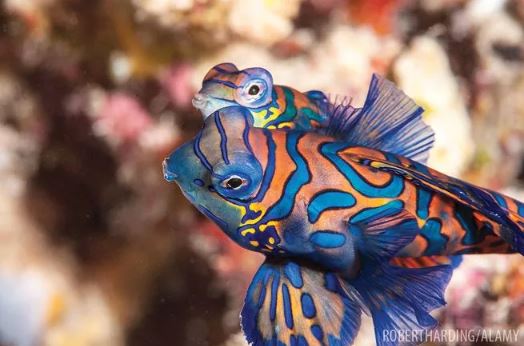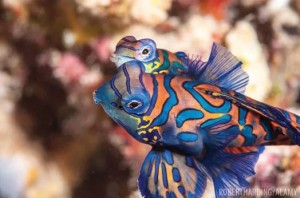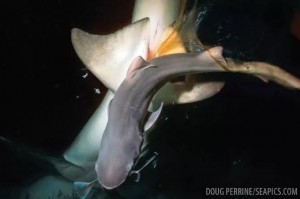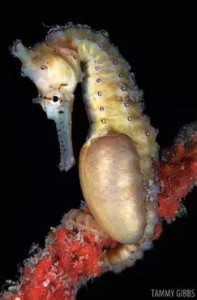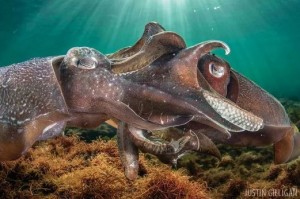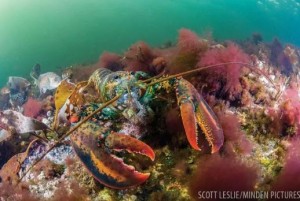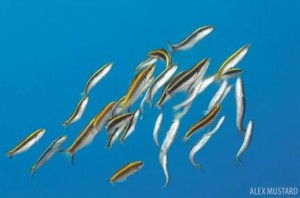Underwater dating and mating games often look nothing like they do on land. Yet, the consequences of these strange sex acts surround us on every dive — both the abundance and variety of life result from successful sex in species from shrimp to sharks. Here are a few of the strategies that fuel the undersea diversity and bounty we all depend upon.
Mandarinfish
Splendid mandarinfish (aka mandarin dragonets) are masters of the fan dance. Instead of ostrich feathers, however, males flash elaborately decorated half-moon fins to seduce females. The goal of this intricate display is simple: look larger than life.
To achieve this, a male flares his pectoral fins, which stick out like indigo-rimmed pingpong paddles just behind his head. To accentuate his size even further, he flicks his large front dorsal spine, which hoists a colorful, sail-like fin along his back. He also raises a second broad dorsal fin that sits behind the first, creating the illusion that he is twice as “tall” as he really is. To balance this top-heavy look, he extends his rounded anal fin like a keel below his body.
As a female approaches, the male quivers, sending ripples down his brightly patterned body, while earnestly flapping his fins. The mesmerizing, psychedelic display awes any diver. Impressing a female, however, depends on her size.
Here’s why: In order to mate, a male and female must swim side by side, lining up their vents (the opening where sperm or eggs are released). As the female releases her eggs, the male curls his anal fin underneath her. This “scoop” momentarily contains the eggs — just long enough for the mandarinfish to spray them with his sperm before they are swept out to sea.
The bigger the male, the larger his anal fin. Thus, females look for males larger than themselves to up the odds that he will effectively catch and fertilize all her eggs.
Virgin Births
Sharks and rays are as flexible with their reproduction as they are with their skeletons, including the ability to give virgin birth.
The technical term is facultative parthenogenesis, which means a female can “choose” to create offspring without male DNA. Instead, the egg divides and recombines with itself, producing a genetically distinct individual. First discovered in sharks in captivity, researchers identified virgin birth by wild smalltooth sawfish in 2016. All species now known to have virgin births also reproduce sexually. The current theory is that virgin birthers are likely responding to low dating pools — whether because they are living in a tank without males or are an endangered species.
Seahorses
For centuries, seahorses have been coveted by humans for their supposed powers of male virility. The irony is seahorse sex lasts for only about five seconds.
What’s far more impressive is their old- fashioned courtship.
Each morning, the female meets her male for a brief stroll. They swim together and even entwine their tails, as if holding hands. Then, they part ways until the following morning. When a male wants to take things further, he repeatedly contorts his tail toward his head and then lengthens out. These full-body crunches force water into his pouch, swelling it in size — something the female finds attractive. He might do this for hours.
Eventually, the female swims up and inserts her tubelike ovipositor into the male seahorse’s abdominal pouch.
After weeks of morning greetings and hours of courtship, seahorse “intercourse” lasts only a few seconds as the eggs are transferred. The male then seals the pouch, fertilizes the eggs, and bathes the developing embryos with nutritious fluid. About six weeks later, he’ll give birth to several dozen miniature seahorses. The next morning, he’s ready to go again.
Cuttlefish
Competition for mates can be stiff off Australia’s southern coast, where giant cuttlefish males can out- number females 10-to-1. Only the biggest, toughest males have what it takes to defend — and successfully mate with — a female. The odds are against smaller males, who don’t stand a chance of winning confrontations with big male consorts.
So how can a small male get some action? Pretending to be a female, of course.
Like their close cousins, the octopus and squid, cuttlefish have superior color-changing and shape- shifting abilities. All a small male needs to do is don the muted-brown, mottled tones of a female and shorten his arms a bit, and voilà, he looks just like a she. These cross-dressing cuttlefish then act like females in the process of laying already fertilized eggs. Such females actively reject courtship attempts by larger males. By changing physical appearance and behavior, these small males can sidle up to a guarded female without raising the alarm. The small male then waits for an opportune moment — perhaps when the big male is challenged by another suitor — to instantly flash his true colors: sexy stripes that cascade across his body. Females often will accept these sneaky advances and mate. It’s then that he reveals his modified fourth arm, the hectocotylus, which is used to transfer his sperm pack to the female.
If the big male suddenly takes notice, the small male immediately shifts his coloration back to female patterns, hoping to avoid a beating. The ploy works most of the time, but it can be risky: Sometimes, the disguise is so good, the bigger male tries to mate with the impostor male!
American Lobster
For female Maine lobsters, sex requires resolving a major dilemma: The best time to mate is just after molting; however, male lobsters are extremely aggressive, and without a strong shell, a female is vulnerable to attack.
So what’s a girl to do?
Seduce the male with a powerful love potion — made of pee, of course.
For several days in a row, a female approaches a male’s den, and when he comes out to defend his territory, she douses him with her urine — through openings called nephropores located under the eyes, no less — before quickly running away. The female American lobster — Homarus americanus — is laying the groundwork for what will be a relatively intimate mating relationship for the underwater world.
After a few days of spritzing, the male shifts from aggressive to receptive — even to the point of fanning the chemical around his home to spread the scent — and welcomes the female into his den. They spend about a week together and then, when the female feels her molt is imminent, she circles in front of the male and “knights” him. She taps one of her big claws on each of his shoulders in a display that researchers think signals “Don’t go anywhere.”
She then proceeds to molt as the male stands guard over her at the back of his den. When she is ready, he gently cradles her now-soft body in his walking legs, using his big tail and front claws to brace himself. He rolls her onto her back and inserts his modified swimming legs into a sperm receptacle at the base of her tail. Business taken care of, the male will then stand guard at the front of the den for the next few days as the female’s shell hardens. She leaves once her armor is back intact, and the next female arrives to begin spritzing the male with her own unique love potion.
Bluehead Wrasse
A male bluehead wrasse can take one of two reproductive paths: grow big and win almost exclusive access to females, or stay small and pump all his energy into producing really big testes.
“Supermales” take the first path. They grow large and have a bright-blue head. The smaller males, called initial phase (IP), have yellow and black markings, and no blue head. What they do have are enormous testes — for the sake of comparison, a 200-pound man with the same investment would have 40 pounds of equipment in his pants. A supermale mates with dozens of females a day, pairing off with each, one by one. To satisfy all those females, supermales carefully ration sperm across mating events.
The IP male, in contrast, takes an all-or-nothing approach, carefully choosing the perfect moment to continue his lineage. He selectively dive- bombs a spawning pair, rushing in and releasing up to 10 times as much sperm as the supermale does, right as the female releases her eggs.
If the IP mistimes this maneuver, he risks attack by the supermale or the eggs dispersing before he can fertilize them. Time things right, however, and it pays to be small and sneaky.
Argonaut Octopus
Most octopuses live life on the seafloor, and for many, sex is like a lengthy handshake. The male extends his modified “penis arm” (called a hectocotylus) to place a sticky sperm pack up in the female’s funnel. Argonauts, however, defy octopus convention. First, they spend their days swimming through the open sea, rather than on the bottom. Second, they have sex from afar.
The tiny males reach only about 11⁄2 inches when fully grown, compared with larger foot-long females. But males make up for their small size with an impressively proportioned hectocotylus— longer than the male’s own body! When the moment is right, a male approaches a female and unfolds his love limb.
Then, in a rather extreme act, he self- amputates his specialized appendage and swims away. His hectocotylus must wiggle to the female on its own and implant itself in her mantle. The male then dies — for him, sex is truly a once-in-a- lifetime experience. The female lives on and can draw upon sperm from multiple detached penis arms stuck in her mantle over her lifetime.
By Marah Hardt
Source: Sport Diver







